Continuous Improvement Plan for Latino Engineering Project
VerifiedAdded on 2020/03/16
|10
|3058
|47
Case Study
AI Summary
This case study examines the project management challenges faced by Latino Engineering, a company developing mechanical equipment. The analysis reveals issues stemming from inefficient business processes, leading to customer dissatisfaction and product quality problems. The assignment proposes a continuous improvement plan, utilizing root cause analysis to identify deficiencies in management structure, employee training, and quality control procedures. The plan emphasizes the implementation of tools like cause-and-effect diagrams and interrelationship diagrams to pinpoint operational errors and improve decision-making. The goal is to enhance product quality, improve customer satisfaction, and achieve long-term sustainability by focusing on key areas such as manpower, machinery, methods, and medium. The case study recommends a step-by-step approach to transform business tactics, incorporating quality metrics, and establishing a robust quality control framework. The continuous improvement plan also focuses on improving the efficiency of activities, establishing interrelationships between processes, and using technology and resources to influence change management, ultimately aiming to restore the company's reputation and increase profitability.
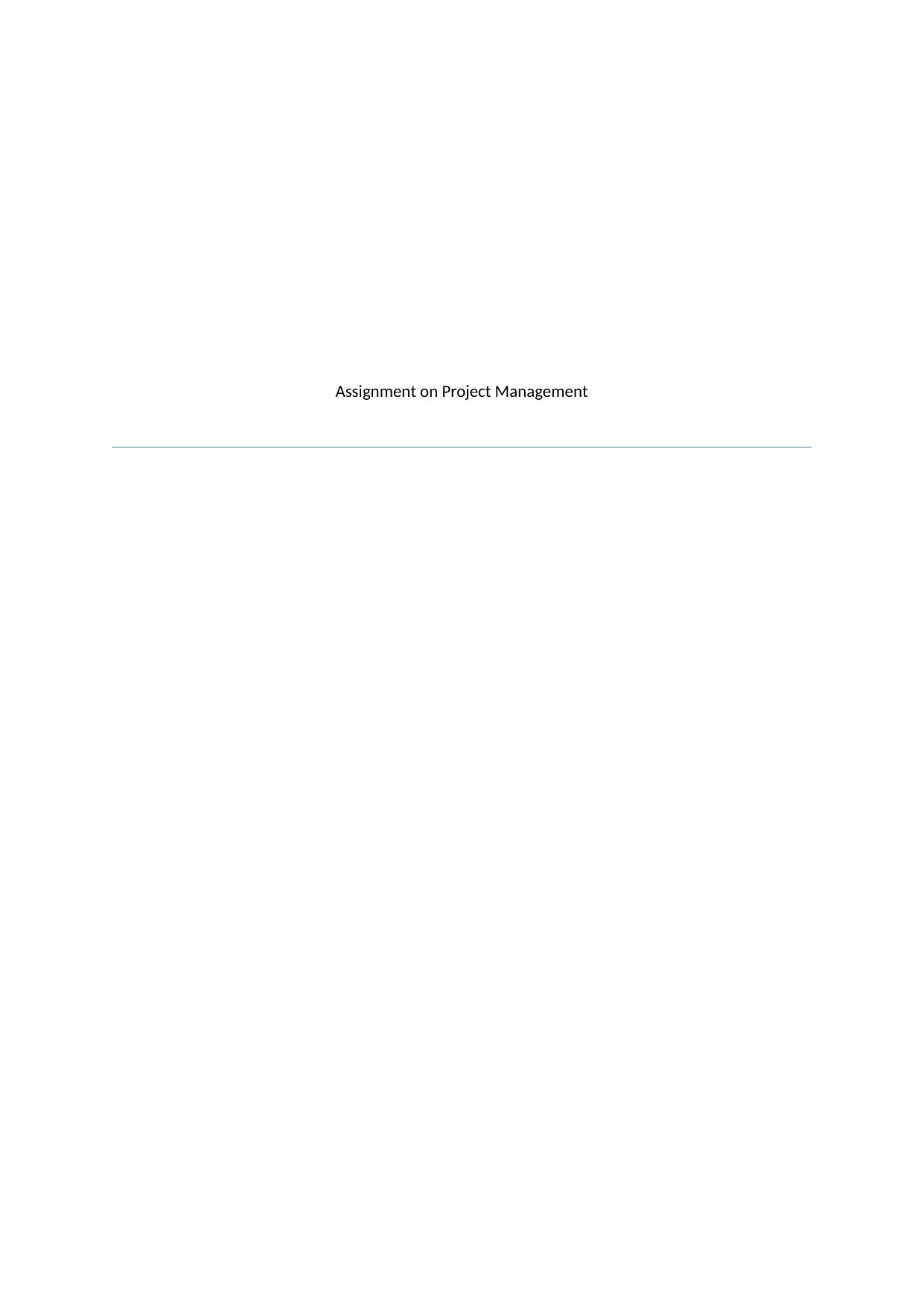
Assignment on Project Management
Paraphrase This Document
Need a fresh take? Get an instant paraphrase of this document with our AI Paraphraser
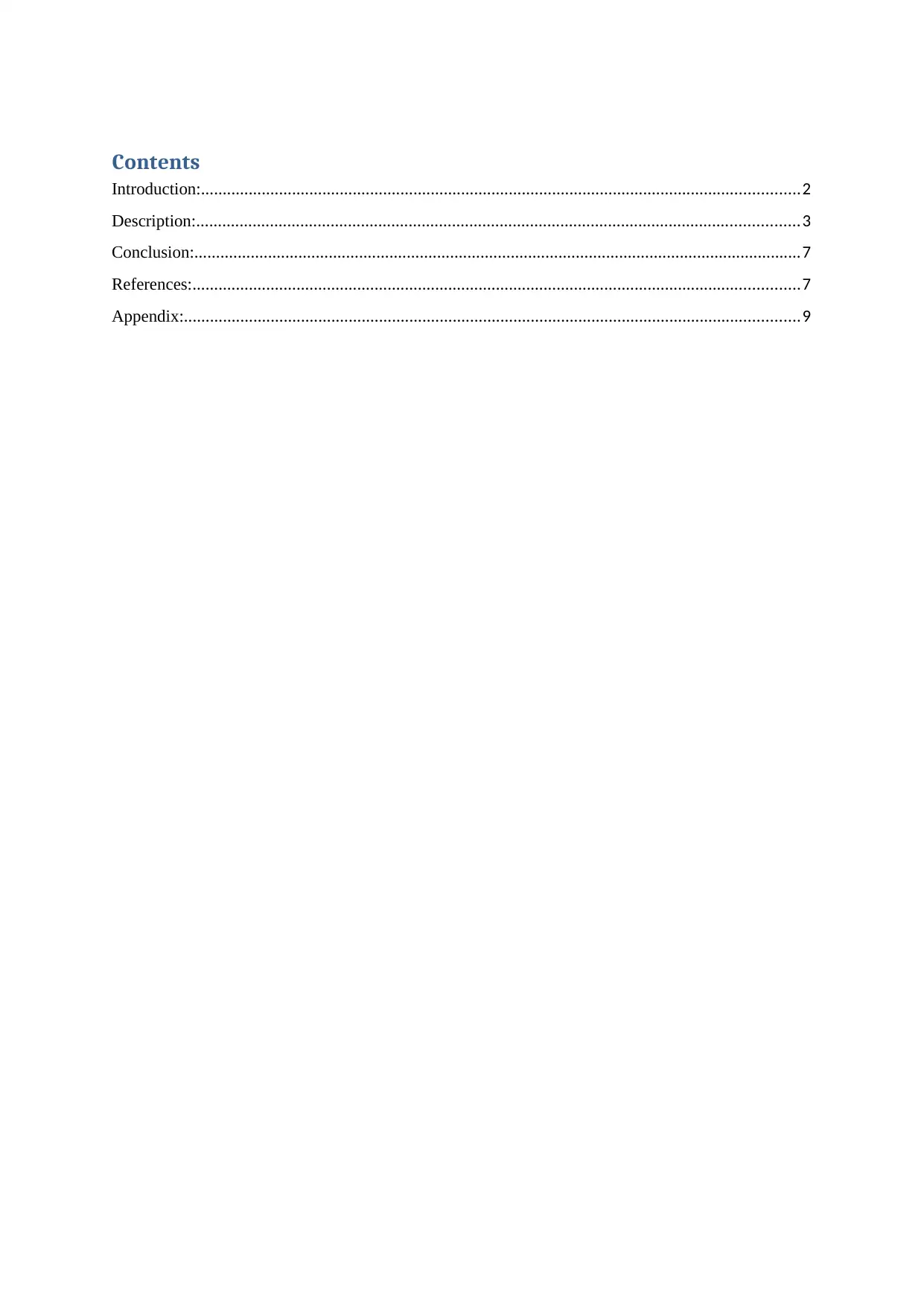
Contents
Introduction:..........................................................................................................................................2
Description:...........................................................................................................................................3
Conclusion:............................................................................................................................................7
References:............................................................................................................................................7
Appendix:..............................................................................................................................................9
Introduction:..........................................................................................................................................2
Description:...........................................................................................................................................3
Conclusion:............................................................................................................................................7
References:............................................................................................................................................7
Appendix:..............................................................................................................................................9
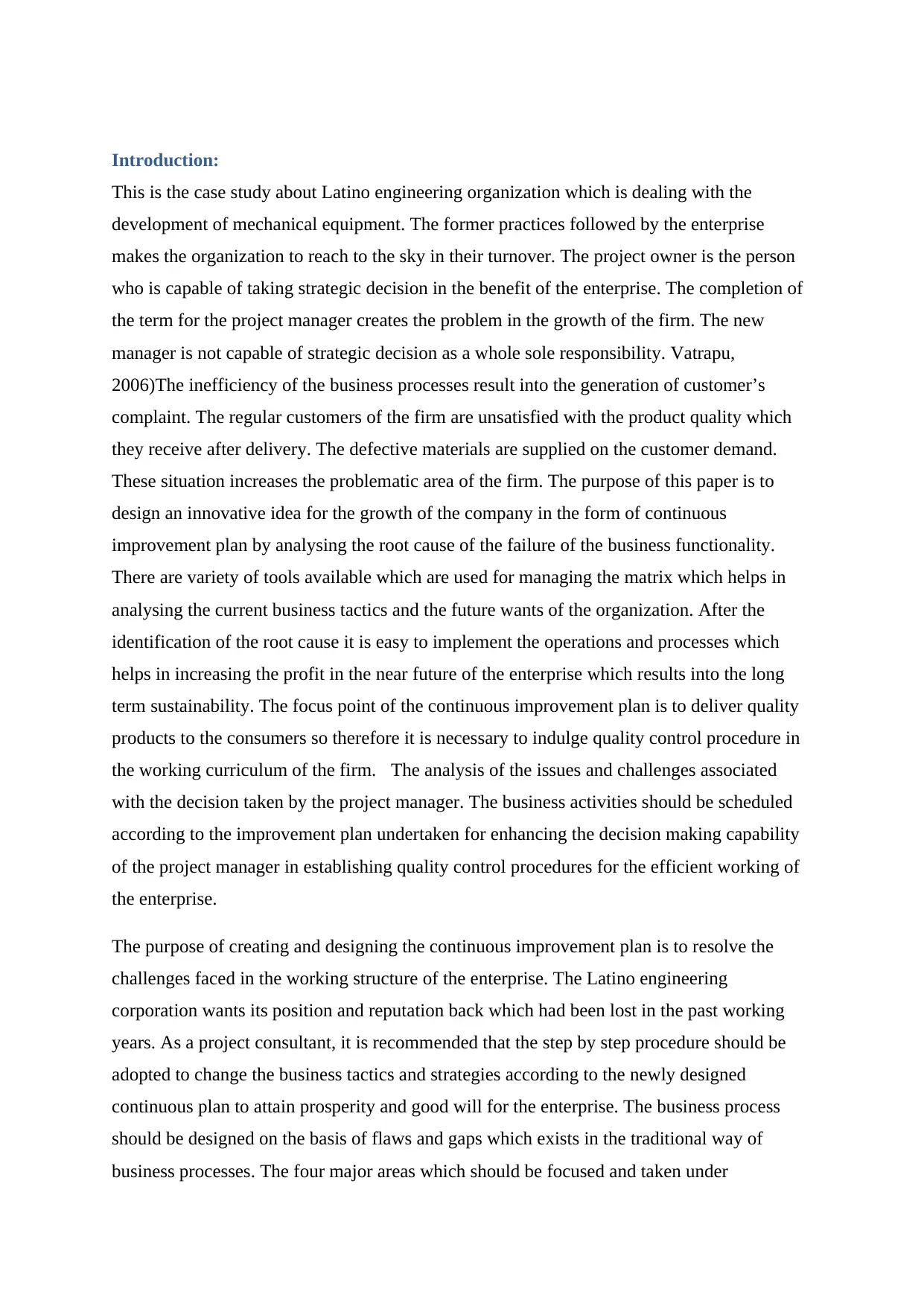
Introduction:
This is the case study about Latino engineering organization which is dealing with the
development of mechanical equipment. The former practices followed by the enterprise
makes the organization to reach to the sky in their turnover. The project owner is the person
who is capable of taking strategic decision in the benefit of the enterprise. The completion of
the term for the project manager creates the problem in the growth of the firm. The new
manager is not capable of strategic decision as a whole sole responsibility. Vatrapu,
2006)The inefficiency of the business processes result into the generation of customer’s
complaint. The regular customers of the firm are unsatisfied with the product quality which
they receive after delivery. The defective materials are supplied on the customer demand.
These situation increases the problematic area of the firm. The purpose of this paper is to
design an innovative idea for the growth of the company in the form of continuous
improvement plan by analysing the root cause of the failure of the business functionality.
There are variety of tools available which are used for managing the matrix which helps in
analysing the current business tactics and the future wants of the organization. After the
identification of the root cause it is easy to implement the operations and processes which
helps in increasing the profit in the near future of the enterprise which results into the long
term sustainability. The focus point of the continuous improvement plan is to deliver quality
products to the consumers so therefore it is necessary to indulge quality control procedure in
the working curriculum of the firm. The analysis of the issues and challenges associated
with the decision taken by the project manager. The business activities should be scheduled
according to the improvement plan undertaken for enhancing the decision making capability
of the project manager in establishing quality control procedures for the efficient working of
the enterprise.
The purpose of creating and designing the continuous improvement plan is to resolve the
challenges faced in the working structure of the enterprise. The Latino engineering
corporation wants its position and reputation back which had been lost in the past working
years. As a project consultant, it is recommended that the step by step procedure should be
adopted to change the business tactics and strategies according to the newly designed
continuous plan to attain prosperity and good will for the enterprise. The business process
should be designed on the basis of flaws and gaps which exists in the traditional way of
business processes. The four major areas which should be focused and taken under
This is the case study about Latino engineering organization which is dealing with the
development of mechanical equipment. The former practices followed by the enterprise
makes the organization to reach to the sky in their turnover. The project owner is the person
who is capable of taking strategic decision in the benefit of the enterprise. The completion of
the term for the project manager creates the problem in the growth of the firm. The new
manager is not capable of strategic decision as a whole sole responsibility. Vatrapu,
2006)The inefficiency of the business processes result into the generation of customer’s
complaint. The regular customers of the firm are unsatisfied with the product quality which
they receive after delivery. The defective materials are supplied on the customer demand.
These situation increases the problematic area of the firm. The purpose of this paper is to
design an innovative idea for the growth of the company in the form of continuous
improvement plan by analysing the root cause of the failure of the business functionality.
There are variety of tools available which are used for managing the matrix which helps in
analysing the current business tactics and the future wants of the organization. After the
identification of the root cause it is easy to implement the operations and processes which
helps in increasing the profit in the near future of the enterprise which results into the long
term sustainability. The focus point of the continuous improvement plan is to deliver quality
products to the consumers so therefore it is necessary to indulge quality control procedure in
the working curriculum of the firm. The analysis of the issues and challenges associated
with the decision taken by the project manager. The business activities should be scheduled
according to the improvement plan undertaken for enhancing the decision making capability
of the project manager in establishing quality control procedures for the efficient working of
the enterprise.
The purpose of creating and designing the continuous improvement plan is to resolve the
challenges faced in the working structure of the enterprise. The Latino engineering
corporation wants its position and reputation back which had been lost in the past working
years. As a project consultant, it is recommended that the step by step procedure should be
adopted to change the business tactics and strategies according to the newly designed
continuous plan to attain prosperity and good will for the enterprise. The business process
should be designed on the basis of flaws and gaps which exists in the traditional way of
business processes. The four major areas which should be focused and taken under
⊘ This is a preview!⊘
Do you want full access?
Subscribe today to unlock all pages.

Trusted by 1+ million students worldwide
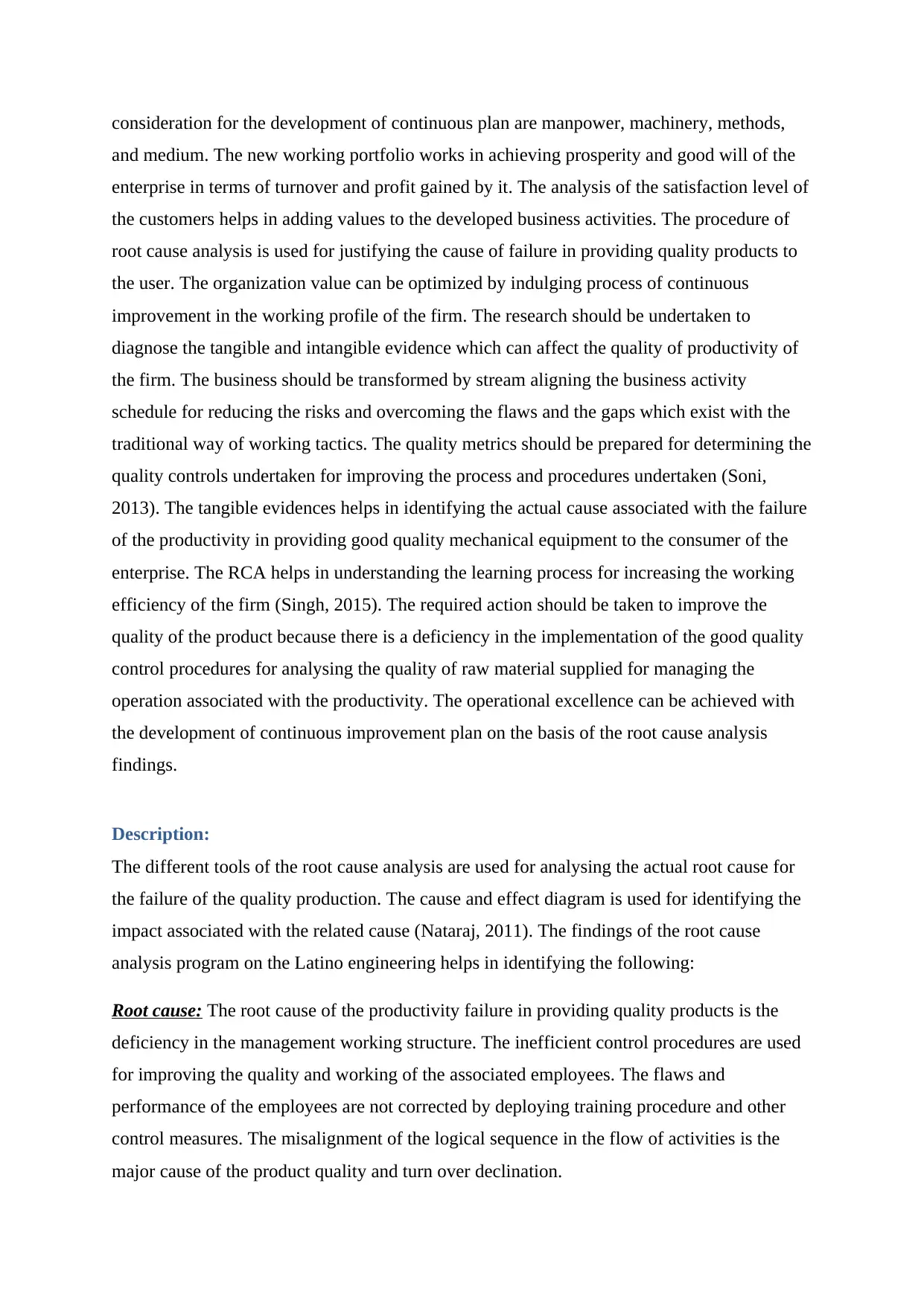
consideration for the development of continuous plan are manpower, machinery, methods,
and medium. The new working portfolio works in achieving prosperity and good will of the
enterprise in terms of turnover and profit gained by it. The analysis of the satisfaction level of
the customers helps in adding values to the developed business activities. The procedure of
root cause analysis is used for justifying the cause of failure in providing quality products to
the user. The organization value can be optimized by indulging process of continuous
improvement in the working profile of the firm. The research should be undertaken to
diagnose the tangible and intangible evidence which can affect the quality of productivity of
the firm. The business should be transformed by stream aligning the business activity
schedule for reducing the risks and overcoming the flaws and the gaps which exist with the
traditional way of working tactics. The quality metrics should be prepared for determining the
quality controls undertaken for improving the process and procedures undertaken (Soni,
2013). The tangible evidences helps in identifying the actual cause associated with the failure
of the productivity in providing good quality mechanical equipment to the consumer of the
enterprise. The RCA helps in understanding the learning process for increasing the working
efficiency of the firm (Singh, 2015). The required action should be taken to improve the
quality of the product because there is a deficiency in the implementation of the good quality
control procedures for analysing the quality of raw material supplied for managing the
operation associated with the productivity. The operational excellence can be achieved with
the development of continuous improvement plan on the basis of the root cause analysis
findings.
Description:
The different tools of the root cause analysis are used for analysing the actual root cause for
the failure of the quality production. The cause and effect diagram is used for identifying the
impact associated with the related cause (Nataraj, 2011). The findings of the root cause
analysis program on the Latino engineering helps in identifying the following:
Root cause: The root cause of the productivity failure in providing quality products is the
deficiency in the management working structure. The inefficient control procedures are used
for improving the quality and working of the associated employees. The flaws and
performance of the employees are not corrected by deploying training procedure and other
control measures. The misalignment of the logical sequence in the flow of activities is the
major cause of the product quality and turn over declination.
and medium. The new working portfolio works in achieving prosperity and good will of the
enterprise in terms of turnover and profit gained by it. The analysis of the satisfaction level of
the customers helps in adding values to the developed business activities. The procedure of
root cause analysis is used for justifying the cause of failure in providing quality products to
the user. The organization value can be optimized by indulging process of continuous
improvement in the working profile of the firm. The research should be undertaken to
diagnose the tangible and intangible evidence which can affect the quality of productivity of
the firm. The business should be transformed by stream aligning the business activity
schedule for reducing the risks and overcoming the flaws and the gaps which exist with the
traditional way of working tactics. The quality metrics should be prepared for determining the
quality controls undertaken for improving the process and procedures undertaken (Soni,
2013). The tangible evidences helps in identifying the actual cause associated with the failure
of the productivity in providing good quality mechanical equipment to the consumer of the
enterprise. The RCA helps in understanding the learning process for increasing the working
efficiency of the firm (Singh, 2015). The required action should be taken to improve the
quality of the product because there is a deficiency in the implementation of the good quality
control procedures for analysing the quality of raw material supplied for managing the
operation associated with the productivity. The operational excellence can be achieved with
the development of continuous improvement plan on the basis of the root cause analysis
findings.
Description:
The different tools of the root cause analysis are used for analysing the actual root cause for
the failure of the quality production. The cause and effect diagram is used for identifying the
impact associated with the related cause (Nataraj, 2011). The findings of the root cause
analysis program on the Latino engineering helps in identifying the following:
Root cause: The root cause of the productivity failure in providing quality products is the
deficiency in the management working structure. The inefficient control procedures are used
for improving the quality and working of the associated employees. The flaws and
performance of the employees are not corrected by deploying training procedure and other
control measures. The misalignment of the logical sequence in the flow of activities is the
major cause of the product quality and turn over declination.
Paraphrase This Document
Need a fresh take? Get an instant paraphrase of this document with our AI Paraphraser
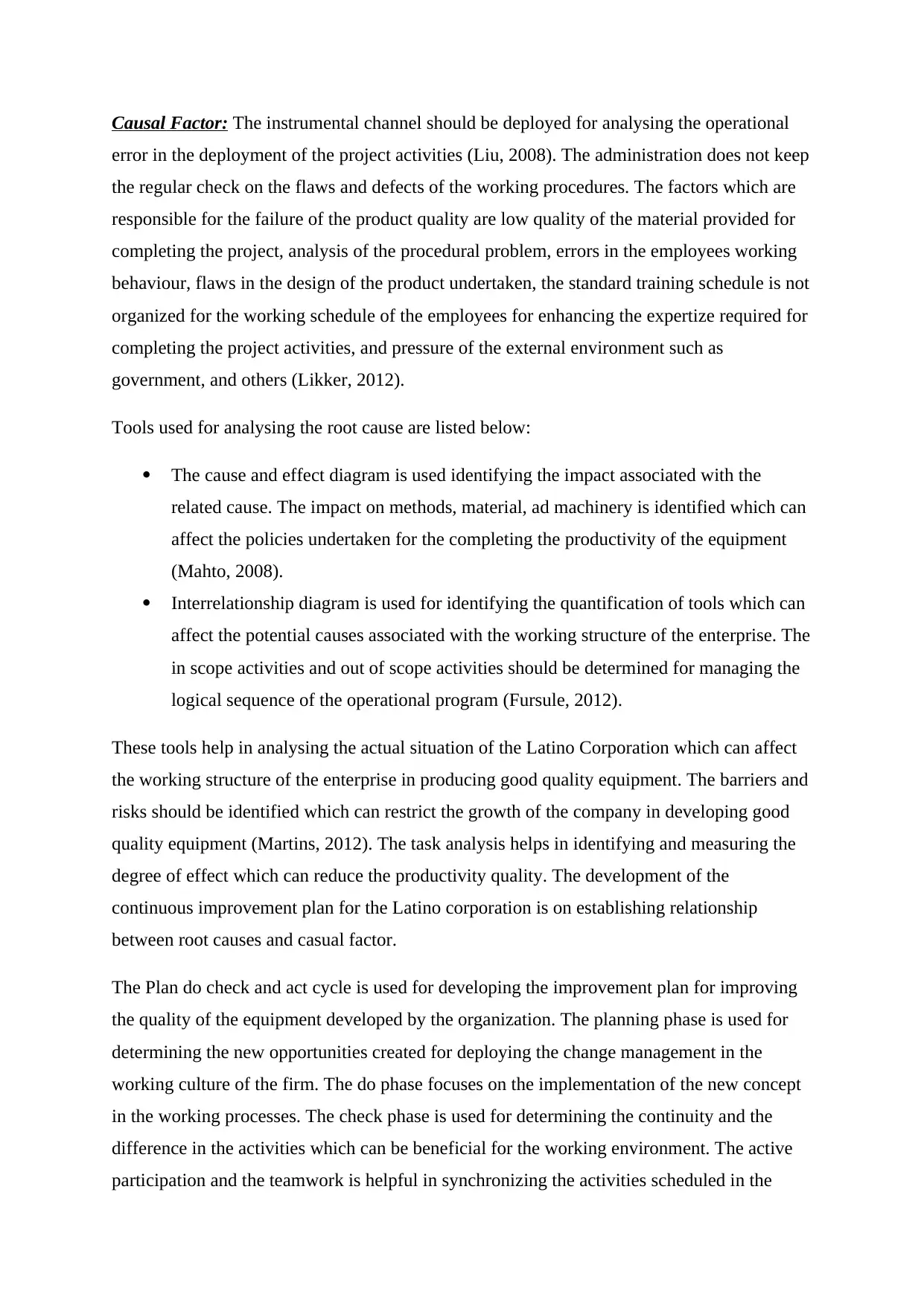
Causal Factor: The instrumental channel should be deployed for analysing the operational
error in the deployment of the project activities (Liu, 2008). The administration does not keep
the regular check on the flaws and defects of the working procedures. The factors which are
responsible for the failure of the product quality are low quality of the material provided for
completing the project, analysis of the procedural problem, errors in the employees working
behaviour, flaws in the design of the product undertaken, the standard training schedule is not
organized for the working schedule of the employees for enhancing the expertize required for
completing the project activities, and pressure of the external environment such as
government, and others (Likker, 2012).
Tools used for analysing the root cause are listed below:
The cause and effect diagram is used identifying the impact associated with the
related cause. The impact on methods, material, ad machinery is identified which can
affect the policies undertaken for the completing the productivity of the equipment
(Mahto, 2008).
Interrelationship diagram is used for identifying the quantification of tools which can
affect the potential causes associated with the working structure of the enterprise. The
in scope activities and out of scope activities should be determined for managing the
logical sequence of the operational program (Fursule, 2012).
These tools help in analysing the actual situation of the Latino Corporation which can affect
the working structure of the enterprise in producing good quality equipment. The barriers and
risks should be identified which can restrict the growth of the company in developing good
quality equipment (Martins, 2012). The task analysis helps in identifying and measuring the
degree of effect which can reduce the productivity quality. The development of the
continuous improvement plan for the Latino corporation is on establishing relationship
between root causes and casual factor.
The Plan do check and act cycle is used for developing the improvement plan for improving
the quality of the equipment developed by the organization. The planning phase is used for
determining the new opportunities created for deploying the change management in the
working culture of the firm. The do phase focuses on the implementation of the new concept
in the working processes. The check phase is used for determining the continuity and the
difference in the activities which can be beneficial for the working environment. The active
participation and the teamwork is helpful in synchronizing the activities scheduled in the
error in the deployment of the project activities (Liu, 2008). The administration does not keep
the regular check on the flaws and defects of the working procedures. The factors which are
responsible for the failure of the product quality are low quality of the material provided for
completing the project, analysis of the procedural problem, errors in the employees working
behaviour, flaws in the design of the product undertaken, the standard training schedule is not
organized for the working schedule of the employees for enhancing the expertize required for
completing the project activities, and pressure of the external environment such as
government, and others (Likker, 2012).
Tools used for analysing the root cause are listed below:
The cause and effect diagram is used identifying the impact associated with the
related cause. The impact on methods, material, ad machinery is identified which can
affect the policies undertaken for the completing the productivity of the equipment
(Mahto, 2008).
Interrelationship diagram is used for identifying the quantification of tools which can
affect the potential causes associated with the working structure of the enterprise. The
in scope activities and out of scope activities should be determined for managing the
logical sequence of the operational program (Fursule, 2012).
These tools help in analysing the actual situation of the Latino Corporation which can affect
the working structure of the enterprise in producing good quality equipment. The barriers and
risks should be identified which can restrict the growth of the company in developing good
quality equipment (Martins, 2012). The task analysis helps in identifying and measuring the
degree of effect which can reduce the productivity quality. The development of the
continuous improvement plan for the Latino corporation is on establishing relationship
between root causes and casual factor.
The Plan do check and act cycle is used for developing the improvement plan for improving
the quality of the equipment developed by the organization. The planning phase is used for
determining the new opportunities created for deploying the change management in the
working culture of the firm. The do phase focuses on the implementation of the new concept
in the working processes. The check phase is used for determining the continuity and the
difference in the activities which can be beneficial for the working environment. The active
participation and the teamwork is helpful in synchronizing the activities scheduled in the
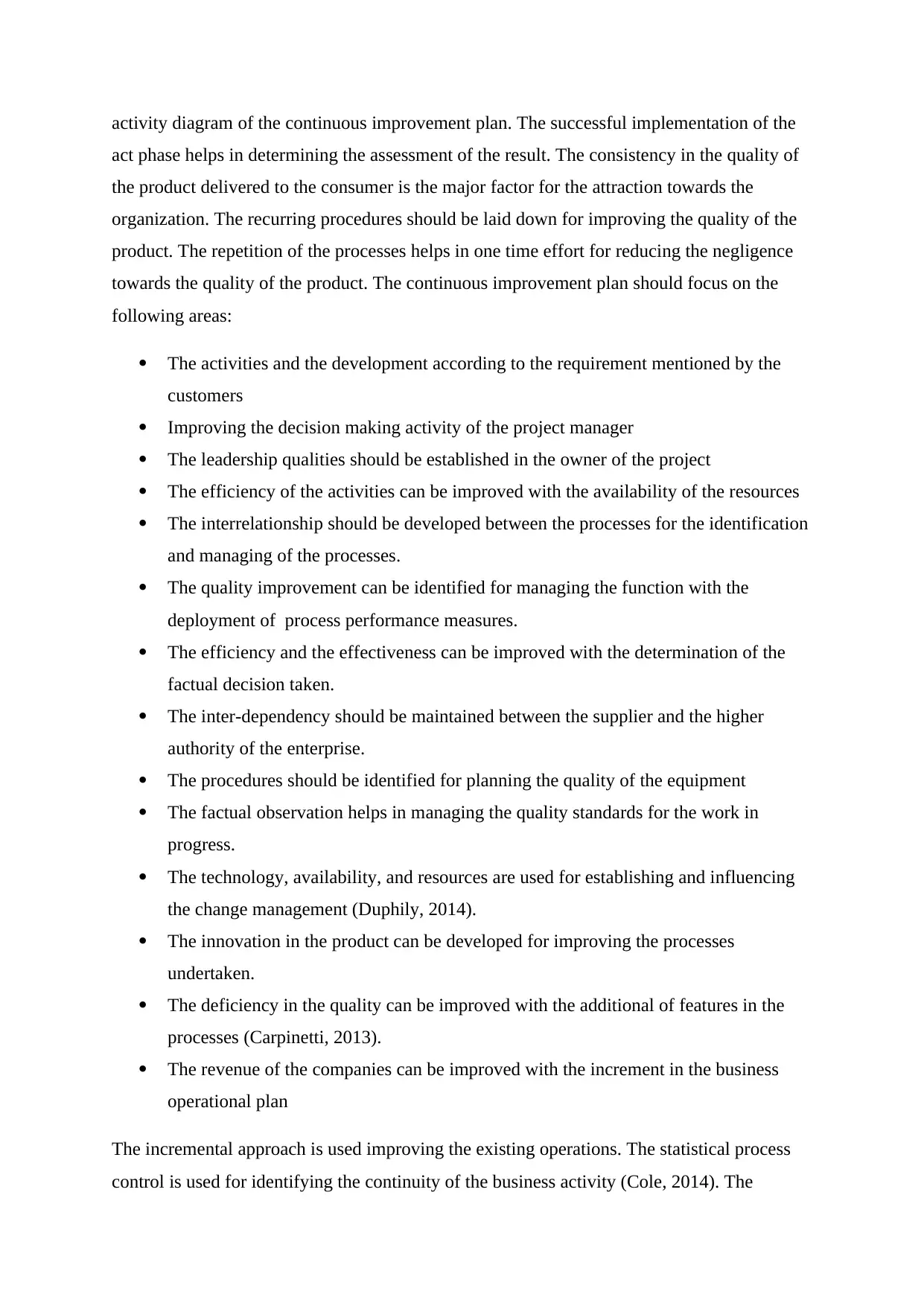
activity diagram of the continuous improvement plan. The successful implementation of the
act phase helps in determining the assessment of the result. The consistency in the quality of
the product delivered to the consumer is the major factor for the attraction towards the
organization. The recurring procedures should be laid down for improving the quality of the
product. The repetition of the processes helps in one time effort for reducing the negligence
towards the quality of the product. The continuous improvement plan should focus on the
following areas:
The activities and the development according to the requirement mentioned by the
customers
Improving the decision making activity of the project manager
The leadership qualities should be established in the owner of the project
The efficiency of the activities can be improved with the availability of the resources
The interrelationship should be developed between the processes for the identification
and managing of the processes.
The quality improvement can be identified for managing the function with the
deployment of process performance measures.
The efficiency and the effectiveness can be improved with the determination of the
factual decision taken.
The inter-dependency should be maintained between the supplier and the higher
authority of the enterprise.
The procedures should be identified for planning the quality of the equipment
The factual observation helps in managing the quality standards for the work in
progress.
The technology, availability, and resources are used for establishing and influencing
the change management (Duphily, 2014).
The innovation in the product can be developed for improving the processes
undertaken.
The deficiency in the quality can be improved with the additional of features in the
processes (Carpinetti, 2013).
The revenue of the companies can be improved with the increment in the business
operational plan
The incremental approach is used improving the existing operations. The statistical process
control is used for identifying the continuity of the business activity (Cole, 2014). The
act phase helps in determining the assessment of the result. The consistency in the quality of
the product delivered to the consumer is the major factor for the attraction towards the
organization. The recurring procedures should be laid down for improving the quality of the
product. The repetition of the processes helps in one time effort for reducing the negligence
towards the quality of the product. The continuous improvement plan should focus on the
following areas:
The activities and the development according to the requirement mentioned by the
customers
Improving the decision making activity of the project manager
The leadership qualities should be established in the owner of the project
The efficiency of the activities can be improved with the availability of the resources
The interrelationship should be developed between the processes for the identification
and managing of the processes.
The quality improvement can be identified for managing the function with the
deployment of process performance measures.
The efficiency and the effectiveness can be improved with the determination of the
factual decision taken.
The inter-dependency should be maintained between the supplier and the higher
authority of the enterprise.
The procedures should be identified for planning the quality of the equipment
The factual observation helps in managing the quality standards for the work in
progress.
The technology, availability, and resources are used for establishing and influencing
the change management (Duphily, 2014).
The innovation in the product can be developed for improving the processes
undertaken.
The deficiency in the quality can be improved with the additional of features in the
processes (Carpinetti, 2013).
The revenue of the companies can be improved with the increment in the business
operational plan
The incremental approach is used improving the existing operations. The statistical process
control is used for identifying the continuity of the business activity (Cole, 2014). The
⊘ This is a preview!⊘
Do you want full access?
Subscribe today to unlock all pages.

Trusted by 1+ million students worldwide
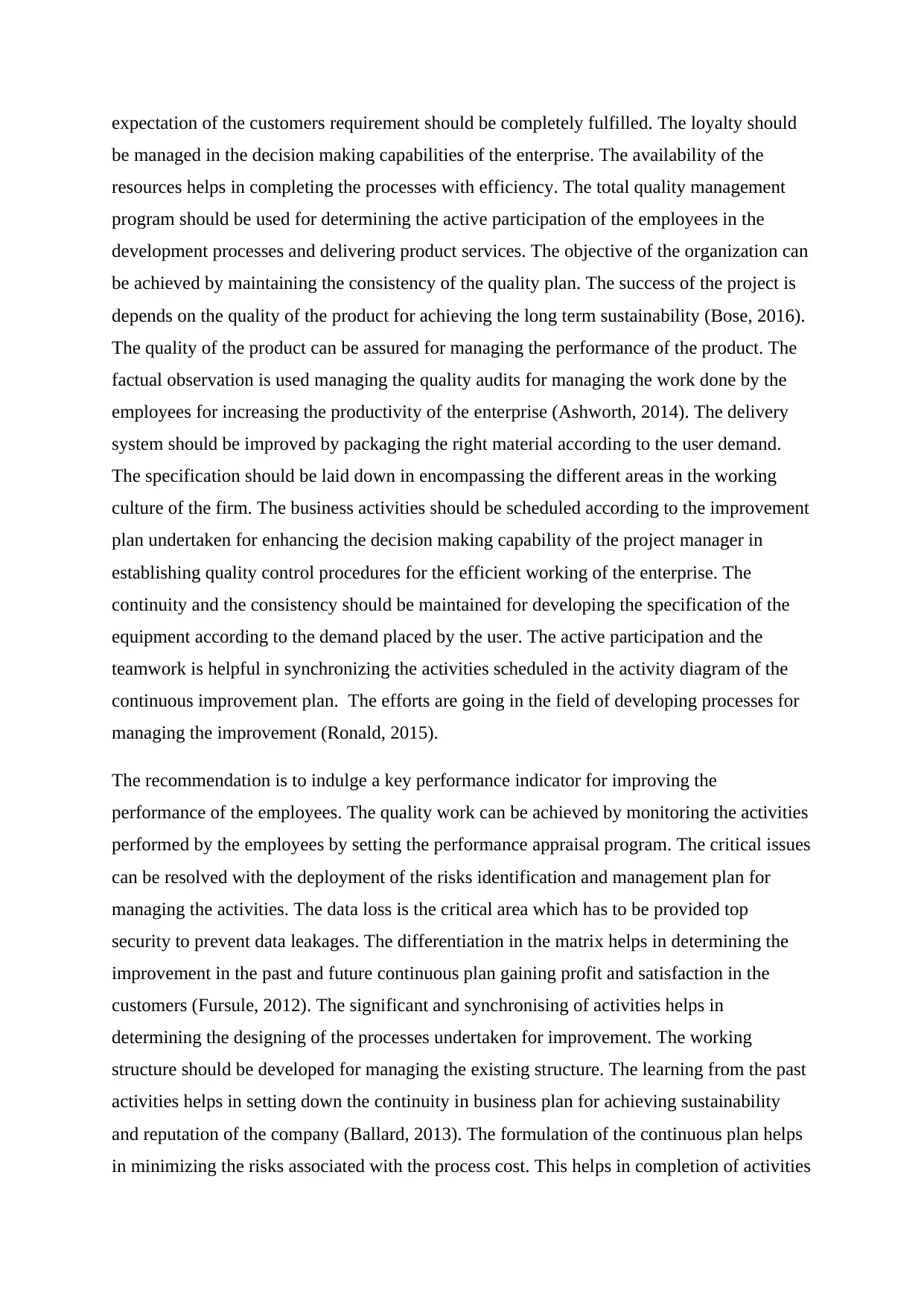
expectation of the customers requirement should be completely fulfilled. The loyalty should
be managed in the decision making capabilities of the enterprise. The availability of the
resources helps in completing the processes with efficiency. The total quality management
program should be used for determining the active participation of the employees in the
development processes and delivering product services. The objective of the organization can
be achieved by maintaining the consistency of the quality plan. The success of the project is
depends on the quality of the product for achieving the long term sustainability (Bose, 2016).
The quality of the product can be assured for managing the performance of the product. The
factual observation is used managing the quality audits for managing the work done by the
employees for increasing the productivity of the enterprise (Ashworth, 2014). The delivery
system should be improved by packaging the right material according to the user demand.
The specification should be laid down in encompassing the different areas in the working
culture of the firm. The business activities should be scheduled according to the improvement
plan undertaken for enhancing the decision making capability of the project manager in
establishing quality control procedures for the efficient working of the enterprise. The
continuity and the consistency should be maintained for developing the specification of the
equipment according to the demand placed by the user. The active participation and the
teamwork is helpful in synchronizing the activities scheduled in the activity diagram of the
continuous improvement plan. The efforts are going in the field of developing processes for
managing the improvement (Ronald, 2015).
The recommendation is to indulge a key performance indicator for improving the
performance of the employees. The quality work can be achieved by monitoring the activities
performed by the employees by setting the performance appraisal program. The critical issues
can be resolved with the deployment of the risks identification and management plan for
managing the activities. The data loss is the critical area which has to be provided top
security to prevent data leakages. The differentiation in the matrix helps in determining the
improvement in the past and future continuous plan gaining profit and satisfaction in the
customers (Fursule, 2012). The significant and synchronising of activities helps in
determining the designing of the processes undertaken for improvement. The working
structure should be developed for managing the existing structure. The learning from the past
activities helps in setting down the continuity in business plan for achieving sustainability
and reputation of the company (Ballard, 2013). The formulation of the continuous plan helps
in minimizing the risks associated with the process cost. This helps in completion of activities
be managed in the decision making capabilities of the enterprise. The availability of the
resources helps in completing the processes with efficiency. The total quality management
program should be used for determining the active participation of the employees in the
development processes and delivering product services. The objective of the organization can
be achieved by maintaining the consistency of the quality plan. The success of the project is
depends on the quality of the product for achieving the long term sustainability (Bose, 2016).
The quality of the product can be assured for managing the performance of the product. The
factual observation is used managing the quality audits for managing the work done by the
employees for increasing the productivity of the enterprise (Ashworth, 2014). The delivery
system should be improved by packaging the right material according to the user demand.
The specification should be laid down in encompassing the different areas in the working
culture of the firm. The business activities should be scheduled according to the improvement
plan undertaken for enhancing the decision making capability of the project manager in
establishing quality control procedures for the efficient working of the enterprise. The
continuity and the consistency should be maintained for developing the specification of the
equipment according to the demand placed by the user. The active participation and the
teamwork is helpful in synchronizing the activities scheduled in the activity diagram of the
continuous improvement plan. The efforts are going in the field of developing processes for
managing the improvement (Ronald, 2015).
The recommendation is to indulge a key performance indicator for improving the
performance of the employees. The quality work can be achieved by monitoring the activities
performed by the employees by setting the performance appraisal program. The critical issues
can be resolved with the deployment of the risks identification and management plan for
managing the activities. The data loss is the critical area which has to be provided top
security to prevent data leakages. The differentiation in the matrix helps in determining the
improvement in the past and future continuous plan gaining profit and satisfaction in the
customers (Fursule, 2012). The significant and synchronising of activities helps in
determining the designing of the processes undertaken for improvement. The working
structure should be developed for managing the existing structure. The learning from the past
activities helps in setting down the continuity in business plan for achieving sustainability
and reputation of the company (Ballard, 2013). The formulation of the continuous plan helps
in minimizing the risks associated with the process cost. This helps in completion of activities
Paraphrase This Document
Need a fresh take? Get an instant paraphrase of this document with our AI Paraphraser
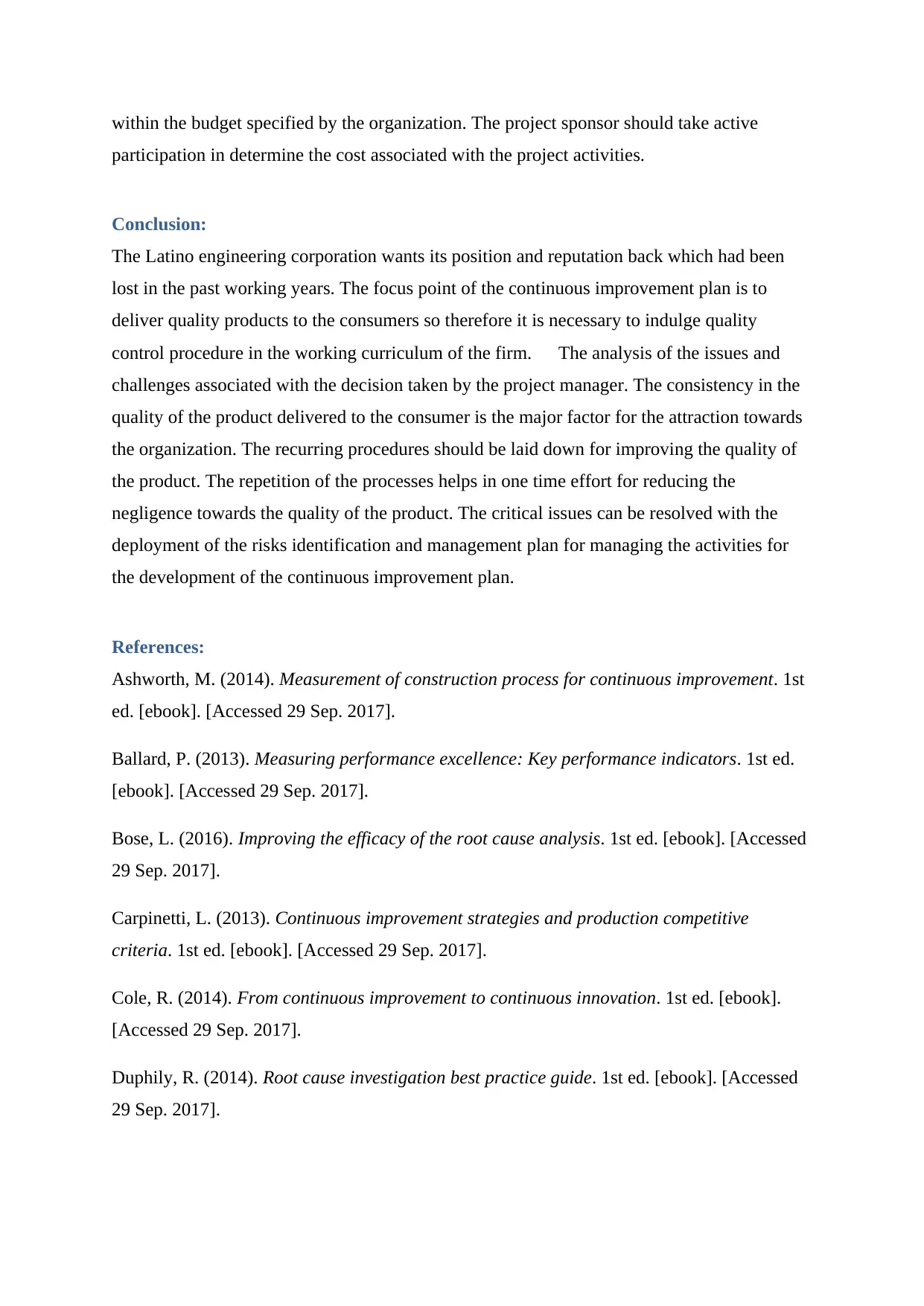
within the budget specified by the organization. The project sponsor should take active
participation in determine the cost associated with the project activities.
Conclusion:
The Latino engineering corporation wants its position and reputation back which had been
lost in the past working years. The focus point of the continuous improvement plan is to
deliver quality products to the consumers so therefore it is necessary to indulge quality
control procedure in the working curriculum of the firm. The analysis of the issues and
challenges associated with the decision taken by the project manager. The consistency in the
quality of the product delivered to the consumer is the major factor for the attraction towards
the organization. The recurring procedures should be laid down for improving the quality of
the product. The repetition of the processes helps in one time effort for reducing the
negligence towards the quality of the product. The critical issues can be resolved with the
deployment of the risks identification and management plan for managing the activities for
the development of the continuous improvement plan.
References:
Ashworth, M. (2014). Measurement of construction process for continuous improvement. 1st
ed. [ebook]. [Accessed 29 Sep. 2017].
Ballard, P. (2013). Measuring performance excellence: Key performance indicators. 1st ed.
[ebook]. [Accessed 29 Sep. 2017].
Bose, L. (2016). Improving the efficacy of the root cause analysis. 1st ed. [ebook]. [Accessed
29 Sep. 2017].
Carpinetti, L. (2013). Continuous improvement strategies and production competitive
criteria. 1st ed. [ebook]. [Accessed 29 Sep. 2017].
Cole, R. (2014). From continuous improvement to continuous innovation. 1st ed. [ebook].
[Accessed 29 Sep. 2017].
Duphily, R. (2014). Root cause investigation best practice guide. 1st ed. [ebook]. [Accessed
29 Sep. 2017].
participation in determine the cost associated with the project activities.
Conclusion:
The Latino engineering corporation wants its position and reputation back which had been
lost in the past working years. The focus point of the continuous improvement plan is to
deliver quality products to the consumers so therefore it is necessary to indulge quality
control procedure in the working curriculum of the firm. The analysis of the issues and
challenges associated with the decision taken by the project manager. The consistency in the
quality of the product delivered to the consumer is the major factor for the attraction towards
the organization. The recurring procedures should be laid down for improving the quality of
the product. The repetition of the processes helps in one time effort for reducing the
negligence towards the quality of the product. The critical issues can be resolved with the
deployment of the risks identification and management plan for managing the activities for
the development of the continuous improvement plan.
References:
Ashworth, M. (2014). Measurement of construction process for continuous improvement. 1st
ed. [ebook]. [Accessed 29 Sep. 2017].
Ballard, P. (2013). Measuring performance excellence: Key performance indicators. 1st ed.
[ebook]. [Accessed 29 Sep. 2017].
Bose, L. (2016). Improving the efficacy of the root cause analysis. 1st ed. [ebook]. [Accessed
29 Sep. 2017].
Carpinetti, L. (2013). Continuous improvement strategies and production competitive
criteria. 1st ed. [ebook]. [Accessed 29 Sep. 2017].
Cole, R. (2014). From continuous improvement to continuous innovation. 1st ed. [ebook].
[Accessed 29 Sep. 2017].
Duphily, R. (2014). Root cause investigation best practice guide. 1st ed. [ebook]. [Accessed
29 Sep. 2017].
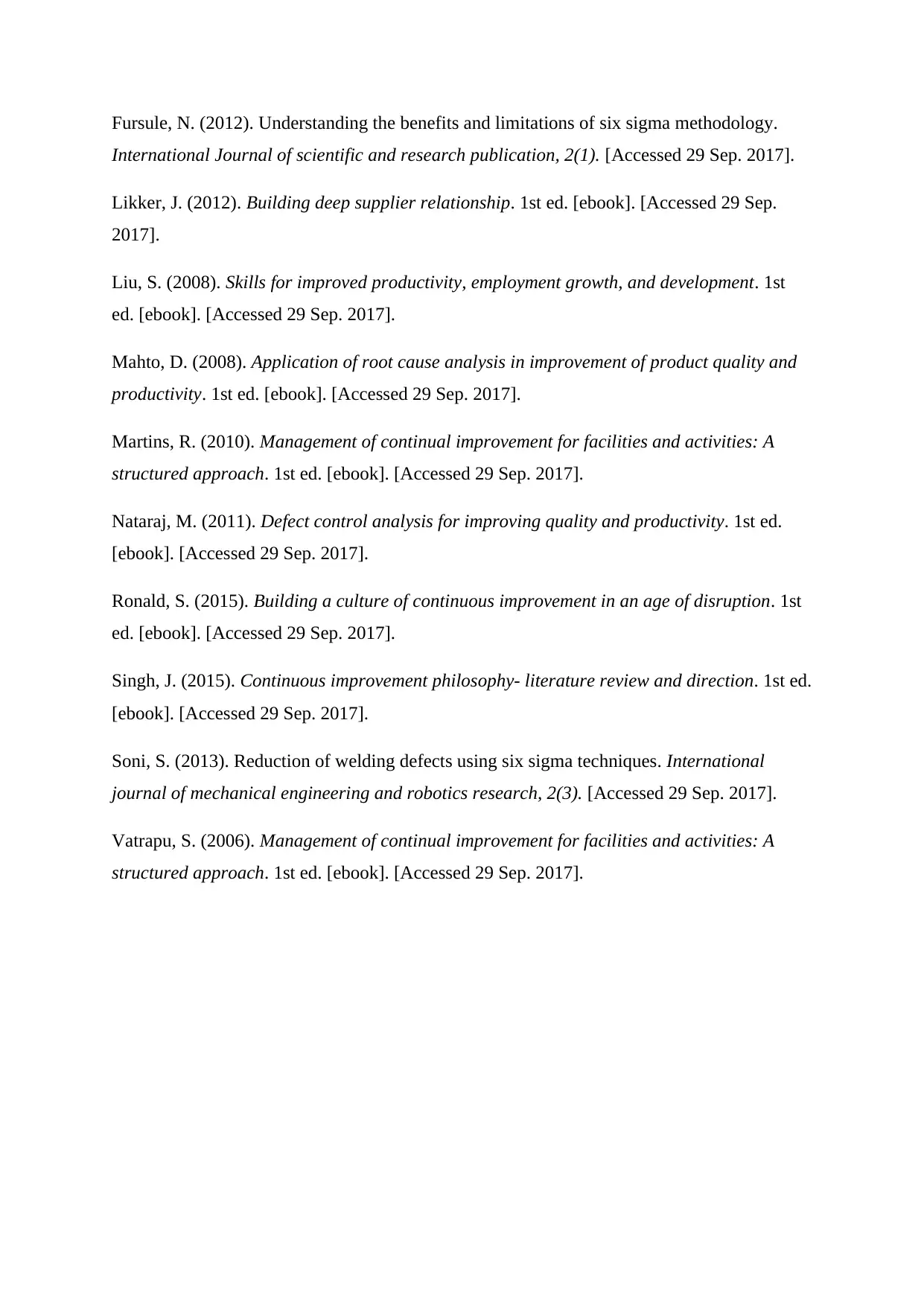
Fursule, N. (2012). Understanding the benefits and limitations of six sigma methodology.
International Journal of scientific and research publication, 2(1). [Accessed 29 Sep. 2017].
Likker, J. (2012). Building deep supplier relationship. 1st ed. [ebook]. [Accessed 29 Sep.
2017].
Liu, S. (2008). Skills for improved productivity, employment growth, and development. 1st
ed. [ebook]. [Accessed 29 Sep. 2017].
Mahto, D. (2008). Application of root cause analysis in improvement of product quality and
productivity. 1st ed. [ebook]. [Accessed 29 Sep. 2017].
Martins, R. (2010). Management of continual improvement for facilities and activities: A
structured approach. 1st ed. [ebook]. [Accessed 29 Sep. 2017].
Nataraj, M. (2011). Defect control analysis for improving quality and productivity. 1st ed.
[ebook]. [Accessed 29 Sep. 2017].
Ronald, S. (2015). Building a culture of continuous improvement in an age of disruption. 1st
ed. [ebook]. [Accessed 29 Sep. 2017].
Singh, J. (2015). Continuous improvement philosophy- literature review and direction. 1st ed.
[ebook]. [Accessed 29 Sep. 2017].
Soni, S. (2013). Reduction of welding defects using six sigma techniques. International
journal of mechanical engineering and robotics research, 2(3). [Accessed 29 Sep. 2017].
Vatrapu, S. (2006). Management of continual improvement for facilities and activities: A
structured approach. 1st ed. [ebook]. [Accessed 29 Sep. 2017].
International Journal of scientific and research publication, 2(1). [Accessed 29 Sep. 2017].
Likker, J. (2012). Building deep supplier relationship. 1st ed. [ebook]. [Accessed 29 Sep.
2017].
Liu, S. (2008). Skills for improved productivity, employment growth, and development. 1st
ed. [ebook]. [Accessed 29 Sep. 2017].
Mahto, D. (2008). Application of root cause analysis in improvement of product quality and
productivity. 1st ed. [ebook]. [Accessed 29 Sep. 2017].
Martins, R. (2010). Management of continual improvement for facilities and activities: A
structured approach. 1st ed. [ebook]. [Accessed 29 Sep. 2017].
Nataraj, M. (2011). Defect control analysis for improving quality and productivity. 1st ed.
[ebook]. [Accessed 29 Sep. 2017].
Ronald, S. (2015). Building a culture of continuous improvement in an age of disruption. 1st
ed. [ebook]. [Accessed 29 Sep. 2017].
Singh, J. (2015). Continuous improvement philosophy- literature review and direction. 1st ed.
[ebook]. [Accessed 29 Sep. 2017].
Soni, S. (2013). Reduction of welding defects using six sigma techniques. International
journal of mechanical engineering and robotics research, 2(3). [Accessed 29 Sep. 2017].
Vatrapu, S. (2006). Management of continual improvement for facilities and activities: A
structured approach. 1st ed. [ebook]. [Accessed 29 Sep. 2017].
⊘ This is a preview!⊘
Do you want full access?
Subscribe today to unlock all pages.

Trusted by 1+ million students worldwide
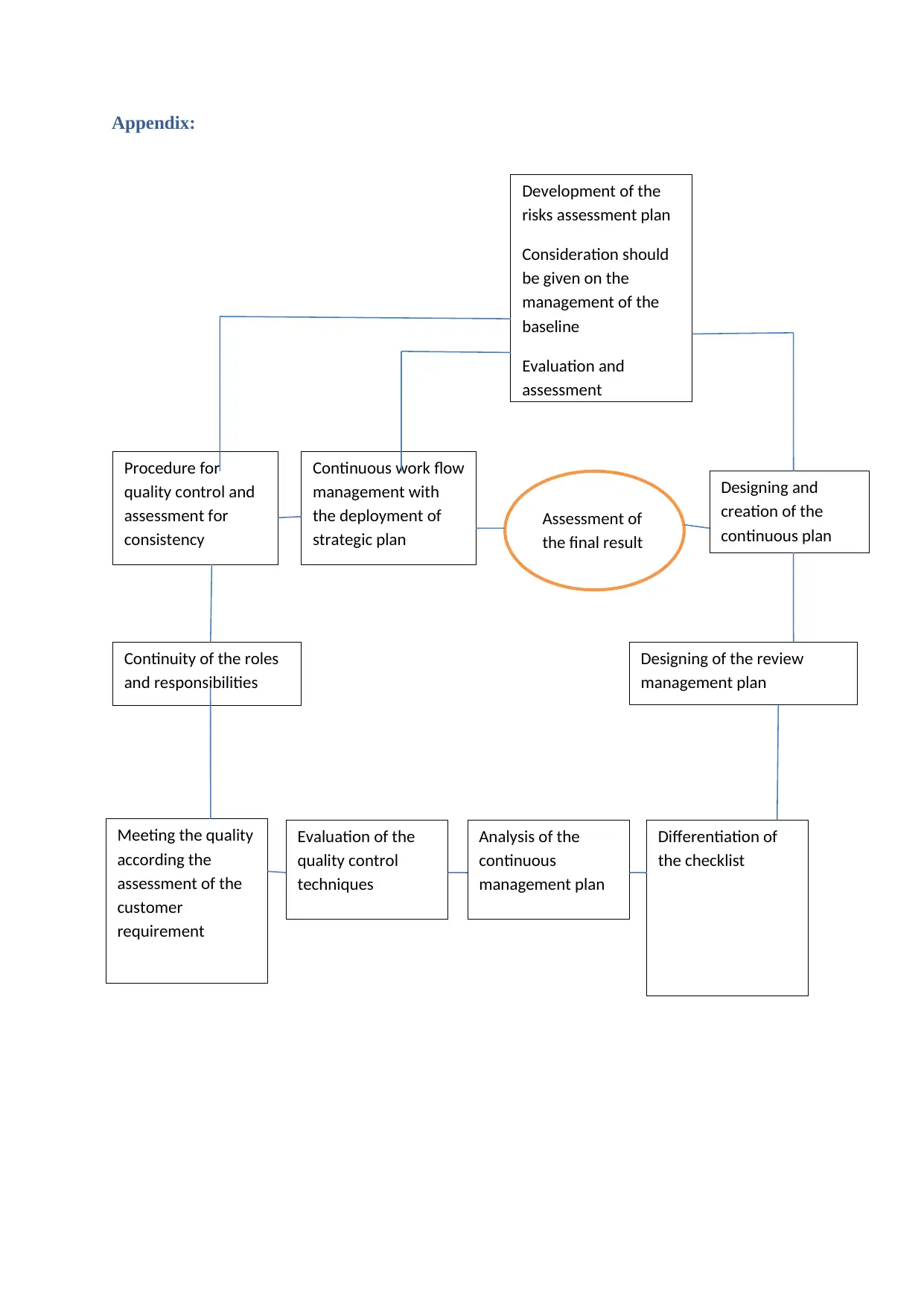
Appendix:
Development of the
risks assessment plan
Consideration should
be given on the
management of the
baseline
Evaluation and
assessment
Procedure for
quality control and
assessment for
consistency
Continuous work flow
management with
the deployment of
strategic plan
Assessment of
the final result
Designing and
creation of the
continuous plan
Continuity of the roles
and responsibilities
Designing of the review
management plan
Meeting the quality
according the
assessment of the
customer
requirement
Evaluation of the
quality control
techniques
Analysis of the
continuous
management plan
Differentiation of
the checklist
Development of the
risks assessment plan
Consideration should
be given on the
management of the
baseline
Evaluation and
assessment
Procedure for
quality control and
assessment for
consistency
Continuous work flow
management with
the deployment of
strategic plan
Assessment of
the final result
Designing and
creation of the
continuous plan
Continuity of the roles
and responsibilities
Designing of the review
management plan
Meeting the quality
according the
assessment of the
customer
requirement
Evaluation of the
quality control
techniques
Analysis of the
continuous
management plan
Differentiation of
the checklist
1 out of 10
Related Documents
Your All-in-One AI-Powered Toolkit for Academic Success.
+13062052269
info@desklib.com
Available 24*7 on WhatsApp / Email
![[object Object]](/_next/static/media/star-bottom.7253800d.svg)
Unlock your academic potential
Copyright © 2020–2025 A2Z Services. All Rights Reserved. Developed and managed by ZUCOL.





